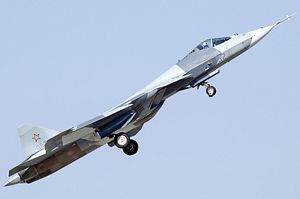The announcement in the Business Standard that the Indian Air Force was less than interested in continuing its relationship with Russia over the PAK FA came as a major surprise. Notwithstanding Indian interest in generation 4.5 fighters such as the Rafale, collaboration with the Russians on the PAK FA was intended to deliver India a fifth generation stealth fighter, as well as a variety of technology transfers. The Indian Air Force had a multitude of complaints, ranging from poor technology to bad engines to sloppy construction.
One lesson is that all advance defense programs have trouble, including the Russian ones. The endless series of difficulties with the F-35 are less the exception that the rule (even granting that the F-35’s troubles may be truly exceptional). We know less about these difficulties because the Russian procurement system isn’t nearly as open to scrutiny as the American one. Russian secrecy doesn’t approach that of Soviet times (Sukhoi recently published a set of patent applications associated with the stealth features of the PAK FA), but it’s not surprising that the problems with the PAK FA have emerged as result of collaboration with India. Indeed, this development lends further support to the idea that the real disciplinary force in fighter acquisition and innovation will be the increasingly sophisticated export market.
From an American point of view, the reassuring part of this story is that every fifth generation fighter project is likely to suffer from significant problems. We’ll know less about the teething problems with the J-20 and the J-31 than of those with the F-35 because China’s defense sector remains closed, but any plausible analysis must take into account the likelihood of technical difficulties. Indeed, given that the Chinese defense industry is considerably less experienced with cutting edge aircraft than even the Russians, it’s almost irresponsible to assume that the PLAAF will avoid operational and procurement pitfalls.
While it might be emotionally satisfying to crow over the deficiencies of an adversary fighter, air forces and navies actually have incentive to do the opposite. A more fearsome opponent serves to drive investment and procurement, while a realistic appraisal of enemy capabilities could result in corresponding cuts. For example, the Department of Defense worried that the MiG-23 was a world-beating fighter, before it tested out a few copies and determined that it was a deeply troubled aircraft. Even after reliable information about the Flogger emerged, it took a long time for assessments of its capabilities to filter through the U.S. defense community.
Granting the complexity of the fifth generation fighter project hardly absolves the Pentagon and Lockheed Martin, but it does put the experience in some perspective. Further, while the problems of the F-35 have surely strained ties with some partners, few have been as vocal about rejecting the aircraft as the Business Standard story suggests of the IAF. Moving forward, the question becomes whether India will use this incident to leverage a better deal out of the Russians, or if it will look elsewhere for its fifth generation fighter requirements.
































